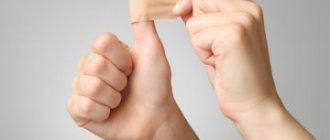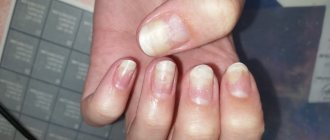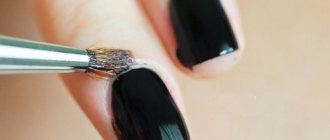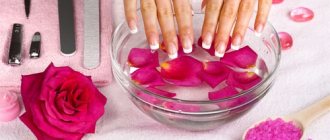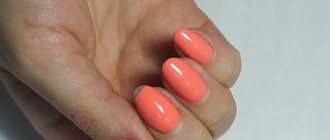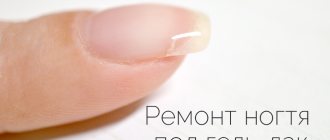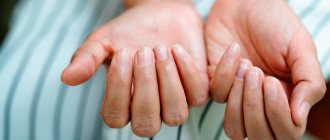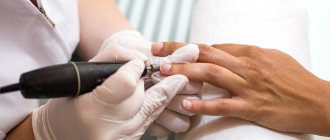Beautiful nails make hands and feet look neat and well-groomed; in addition, nail plates have a protective function and protect the nail bed from injury. In the area of the nail bed there are nerve endings and blood vessels that are responsible for the sensitivity of the fingers.
Sometimes there are situations when the nail needs to be removed, there are many reasons for this. In this case, after some time the nail plate begins to grow again. Many patients are interested in how quickly the nail will recover and how to make it beautiful and smooth. Proper care after the procedure will help with this.
Why do you need to remove the nail plate?
First of all, the fungus (onychomycosis) attacks the big toe. The reason is simple: the main part of the nail is often found in shoes. Bacteria that get on the plate begin to actively spread and cause harm. The nail may become curled and the finger may swell. Usually a person seeks medical help at this stage: unsuccessful self-medication leads to the neglect of the condition. When a fungus appears, the attending physician carries out therapy, prescribing various ointments and drops. They are designed to destroy the root of the disease. If the stage is late, then the medications cannot reach their target. Advanced cases require long-term therapy. Factors such as excessive sweating of the feet or certain features of shoes can complicate treatment. In order for drugs to access the source of infection, it is necessary to remove the affected area. This is the fastest way to get rid of onychomycosis. Removal of the plate is prescribed in the following cases:
- at least 70% of the nail is infected;
- the affected plate structure and finger swelling make it difficult to walk;
- the infection caused an ingrown nail;
- the root of the nail plate is infected;
- relapses.
Since the nail has a protective function, removing it completely is dangerous. This can provoke additional infection and cause severe discomfort during the recovery period. In some cases, only the top layer or a certain part of the nail plate requires removal. If previously the fungus was gotten rid of only with the help of medications or surgery, today more effective and painless methods have appeared.
Diagnosis of the disease
What to do with an ingrown toenail ? As soon as you see that your toenail is growing into the skin, you should definitely consult a doctor.
Diagnosis of the disease will be based on an external examination, the patient’s medical history, questioning and collection of his complaints. In addition, diagnosis is impossible without laboratory tests:
- General blood analysis. Allows you to assess the condition of the body, detect the inflammatory process and draw a conclusion about the need for surgical treatment.
- Blood test for glucose. This study will look for diabetes or metabolic disorders that may be an indirect factor activating inflammation.
- X-ray of the foot. Thanks to this instrumental method, the doctor will be able to detect an inflammatory process on the bone, or the formation of osteophytes (bone outgrowths).
If the doctor suspects the presence of a fungal infection, he will refer you to a specialized specialist - a dermatologist, who will begin treatment of the ingrown toenail from a dermatological point of view, so that the process does not resume even after resection.
If an ingrown toenail is not diagnosed in time, the problem becomes chronic. As a rule, half of the patients who did not seek medical help in time suffer from onychocryptosis.
At the medical clinic, experienced doctors treat ingrown toenails painlessly and at the best price!
Treatment options
There are therapeutic and surgical (using surgery) methods for treating ingrown toenails. Therapy should be carried out under the strict supervision of the attending physician, and self-medication should be avoided!
Therapeutic methods for eliminating the disease include the following methods:
- Use of non-steroidal anti-inflammatory drugs. The remedies will help reduce the intensity of inflammation and reduce pain. As a rule, patients take Paracetamol or Ibuprofen, the dosage is determined by the attending physician. The patient takes pain relief for an ingrown toenail if the pain is too severe.
- Special baths for disinfection. How to soften an ingrown toenail ? Baths are performed 2-4 times a day: ordinary baking soda, potassium permanganate or sea salt must be dissolved in water. Thanks to the baths, the tissues soften, and the problem of how to cut out an ingrown toenail no longer worries the patient. After removing the nail, the area must be treated with iodine or brilliant green.
- Using Vishnevsky ointment. Vishnevsky ointment is indispensable for infectious processes. The bandage should be applied to the area of inflammation at night and removed in the morning. Even a severely ingrown nail can be removed in the morning, when it comes out from under the roller.
In addition, doctors advise using ichthyol ointment, which relieves inflammation and reduces irritation. The bandage must also be applied at night, and the nail must be cut in the morning. An ingrown toenail can also be removed using these methods.
The following methods are used as surgical methods for treating ingrown toenails:
- Cauterization using a laser. The method is effective if ingrown nails occur at the cuticle level. Thanks to the laser, it is possible to prevent relapses because the laser removes germ cells, the site of inflammation and young granulation tissue.
- Resection of an ingrown nail. The doctor performs the operation under local anesthesia, and in this case the entire nail plate has to be removed, because one of the indications for resection is a suppurative process. After 3 months, a person grows a new nail.
- Removal using radio wave technology. A gentle treatment method, thanks to which the patient does not have any scars or stitches on the finger. During the operation, the doctor removes the ingrown part and treats the growth zone to prevent relapse of the disease.
Sometimes the doctor will tamponade the ingrown toenail to stop bleeding or drainage of pus.
After surgery, the intervention area should be treated with an antiseptic solution and antibacterial ointment for 3-5 days. For severe pain, the doctor prescribes painkillers. You only need to wear wide shoes so as not to put pressure on the operated area.
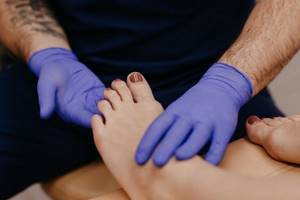
Surgical nail removal
Radical measures became one of the first ways to combat lesions of the nail plates. Today they are used quite rarely, except in small government medical institutions. The exception is complex and advanced cases. In such situations, it is necessary to completely remove the nail plate from the bed in order to open the way for the growth of a healthy nail. Before the procedure, the patient undergoes an examination to exclude contraindications:
- poor blood clotting;
- capillary permeability and dilated veins;
- diabetes mellitus (also has a negative effect on stopping bleeding);
- intolerance to anesthesia;
- diseases of the immune system;
- short-term inflammations and infections (ARVI, sore throat).
Then the day of surgery is set. The procedure is painful, so local anesthesia is required. The operation itself is simple and goes quickly. The patient will have to go through the following procedures:
When the anesthesia wears off, the patient may experience pain and itching. Bed rest is required for the first 30 days after surgery. This is necessary so that a healthy nail grows evenly along the bed. An open wound requires daily care with dressing and medication. In the first days, bleeding is possible, so before a crust forms, it is important to prevent a new infection. After surgical removal of the nail, it is better to go to the hospital for the period of adaptation. This will save you and your family from the hassle of dressings and protect against new infections. You will always be under supervision, and if something goes wrong, the doctor will be able to react quickly. When treating at home, you need to visit the hospital once a week so that the doctor keeps the new nail plate under control. Everyone's nail growth rate is different. On average, a completely healthy plate appears in six months. This video demonstrates all the stages of the operation to remove a nail due to fungus. Children and people intolerant to the sight of blood should avoid viewing.
Folk remedies
Many people are interested in how to restore nails at home. After removing a nail, you can use folk remedies for quick healing, relief of inflammation and pain. Before using the product, it is better to consult a doctor and make sure that there is no allergy to its components. It is also not recommended to mix pharmaceutical and folk remedies with each other; they must be applied one at a time. Useful recipes:
- Herbal baths have excellent healing and anti-inflammatory effects. As soon as the wound heals, you can carry out this procedure 2-3 times a week. To do this, brew a herb, for example, chamomile, sage or string, filter the decoction and pour it into warm water. The feet are immersed in the bath for 15 minutes.
- When the nail has already begun to grow, natural salt baths will help strengthen it. For 500 ml you need to take 4 tablespoons of natural sea salt without dyes and flavors. Repeat the procedure 3 times a week.
- 2 times a week you need to apply iodine to the cuticle with a cotton swab in a thin layer. This product will help speed up the growth of nails and make them healthy and beautiful.
- To make a weak nail strong, you need to lubricate it every day with grape seed oil or natural olive oil, you can also add essential oils, such as orange.
- If the nail grows very slowly, it is thin and peeling, a lemon mask will help. To do this, apply a piece of lemon to the nail and secure it with a bandage, leave for 15 minutes, then rinse the skin with water.
It is important to note that all folk remedies can be used only after the wound has completely healed. Until this moment, the nail bed should be covered with a sterile bandage, and only ointments, for example, levomikol, can be applied to the wound, and only if this is recommended by the doctor.
Hardware pedicure
This method is also called mechanical. The procedure requires a special device - a milling cutter, which is used for cosmetic manicure. It has a rotating element and replaceable abrasive attachments. It is important to know that nail removal is not a cosmetic procedure, and a doctor, not a pedicurist, should work with a milling cutter.
- diseases associated with poor blood clotting;
- HIV infection;
- capillary permeability;
- diseases of an inflammatory or infectious nature.
After consultation, foci of infection are identified and removal begins. This is a rather lengthy process: one finger can take half an hour. During treatment, the area heats up from friction, but in general, the procedure is painless. It goes like this:
- the treatment area and the device itself are disinfected;
- A softening compound is applied to the nail, which makes filing easier;
- the doctor sequentially removes the stratum corneum, getting to the root of the infection;
- antifungal and antimicrobial agents are applied.
The big advantage of using hardware is that it saves time: cutting is done once. No anesthesia is required, which means no chemicals. Compared to surgical removal, this is a gentler method and rarely causes bleeding. Since there is no open wound, rehabilitation takes less time and there is no discomfort.
Laser therapy
This is the most modern way to remove toenail fungus. It also has maximum efficiency. Unlike the surgical method, the laser selectively approaches the problem. The heat wave penetrates the stratum corneum, drying out only the affected parts and not affecting the healthy ones. Depending on the equipment used, the waves can have different lengths and temperature intensities. This varies the time of therapy. A treatment session for one finger takes 5-7 minutes. To get rid of the infectious agent, several procedures are required. Sessions are carried out with a frequency of 1-2 weeks. The duration of the entire course depends on the size and number of affected areas.
- parallel treatment of oncology;
- epileptic seizures and other mental disorders;
- bearing a child, lactation;
- HIV infection.
For people with a low pain threshold, it is better to notify the doctor so that he can administer local anesthesia. Laser therapy is painless, but a strong burning sensation may be felt during the heating process. This is especially true if the fungus is in the lower layers of the nail plate.
This method is characterized by the absence of relapse of the disease: the fungus is completely destroyed. Unfortunately, laser therapy is rarely found in public clinics, so you need to contact specialized centers for it. The cost of a course of treatment for one finger is more than one and a half thousand rubles.
Step-by-step instruction
It is not recommended to cut your hair in one motion. You need to trim your nails gradually, that is, in several stages. You need to give your nails a shape using a nail file.
- Place a towel or napkin on the floor. This will help you later collect all the clipped nails and throw them away.
- The cut must be made in several stages, without going deep to the ends of the plate. You should not try to trim ingrown toenails in one motion at once, as this may cause separation or damage to nearby tissues.
- It is not recommended to cut the plate at the root. This will cause damage to soft tissues and can cause infection and pain. The strip should always remain a small width.
- Use a nail file to give the desired shape. A buff might also work. There is no need to frequently cut dry-trimmed nails, as they will begin to flake. They can be of various shapes: round, oval, or even rectangular. The form should not have pointed areas. They need to be filed from the edges to the central part.
- Dry your feet with a towel or disposable towel.
- Lubricate your feet with moisturizer, oil, or wax. This will save the skin from drying out and splitting the nail plates.
Before cutting a nail affected by fungus, you need to apply an antifungal cream or gel to it. If you need to trim ingrown toenails, you can rub in a softening or anti-inflammatory cream.
How to remove a nail yourself
In the modern rhythm, everyone does not have enough time, including visiting doctors. And many simply do not trust young doctors. Therefore, the question of self-removal of a nail with fungus on the foot is always relevant. In a clinical setting, the risks are much lower, but if there is no other choice, then you need to strictly follow the instructions below. There are a number of good pharmaceutical products for removing fungal areas. Before using them, you need to soak the affected fingers in a solution of hot water, soap and soda (one teaspoon per liter of water). The nail should steam and soften. The top layer of the plate should be cut off. The drugs are aggressive, so for protection, cover the periungual area with a simple plaster.
- Keratolytic plaster "Ureaplast" is a thick plaster mass. It is distributed over the nail plate, trying not to touch the skin. The compress should be kept for 4-5 days, then check the result. If the nail does not go away, repeat the procedure until it is removed.
- Mikospor ointment has a thinner consistency compared to the patch, but the principle of action is the same. The compress is left here for one day. After which the feet are soaked again for 10 minutes and the softened tissue is removed. It is worth repeating the procedure until the desired result.
- Nailitis. One bottle (15 ml) is enough for 3-4 plates, depending on their size. Apply a thick layer without rubbing, keep the compress for three days.
- Nogtimycin acts in the same way as nailitis. Apply a thick layer and cover for three days. Soak again, clean off the loose layer, apply cream. Repeat until completely removed.
- Kanespor is distinguished by its gentle composition. Acts only on affected areas and does not corrode the skin. Apply once a day, under the patch. After each removal, rinse the foot, scrape off the softened mass and repeat application until the nail bed is clear.
The above drugs and their analogues are used only for removing nail plates. They do not have antifungal properties. Self-medication for fungal infections is fraught with bad consequences. Incompletely removed spores provoke re-infection. Lack of sterility will lead to the spread of fungal infection. In addition, without proper disinfection, another virus may be introduced, due to which the inflammatory process will begin again.
Features of toenail treatment
Tools
- Pedicure nippers , allowing not only to shorten the nail plate, but also to trim off hangnails and keratinized side ridges;
- rounded and straight nail scissors , allowing you to work on the length and shape of the nail plate;
- special pedicure file ;
- separators for fingers, allowing you to handle each of them with greater convenience;
- pumice for rough skin;
- cosmetics for treating the skin of the feet and nail plate.

Pedicure tools
Preparing nails for the procedure
Before a trimmed pedicure, it is best to steam your feet in a warm bath with oils or special cosmetics.
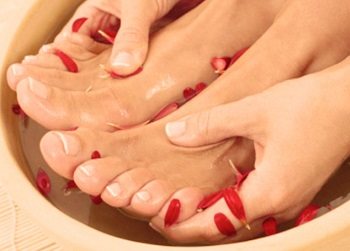
Foot bath before pedicure
First of all, it will moisturize the skin so that it will be easy to process, and in addition, it will soften the nails and cutting them will be painless.
Also, any procedure for treating feet should begin with their complete disinfection: first, any dirt must be wiped off with a rough brush, and then treated with any suitable disinfectant.
Leg cutting technique
When cutting your nails, you should not get too close to the pink part , but leave a small supply of regrown nail plate.
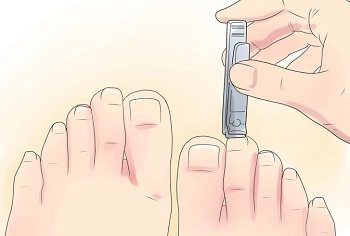
When cutting nails, the clipper should be held at right angles to the nail plate.
Making thick nails into a round shape using scissors or nippers can be dangerous, so they are cut at a right angle, and the sharp corners formed during the cutting process are filed down .
If your nail curls, you can try not cutting its length, but regularly shortening it with a nail file. In this case, after several procedures, the nails will noticeably straighten.
To avoid ingrown toenails, do not try to give your nails a square shape.
Experienced pedicure masters have a lot of their own professional secrets and techniques, which can greatly simplify the process and improve the quality of your home pedicure. Watch this video for a master class on trimmed mechanical pedicure:
Shortening toenails in a hardware pedicure
Hardware pedicure is a set of very simple and absolutely safe procedures for caring for the entire foot. It allows you to shorten the length of your nails and maintain a healthy “after-salon” appearance at home.
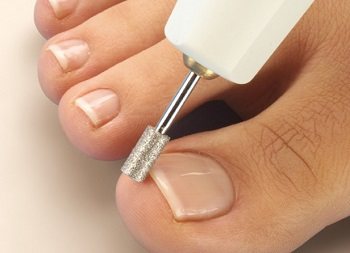
Hardware pedicure
This procedure begins with disinfection of the feet, after which, using a special round file attachment, gradually removed , which in the process are slightly rounded to the corners.
Then, using another cone attachment , the rough skin is removed . It is important to remember that a special cosmetic product is used to soften it, since it is better not to steam your feet before a hardware pedicure.
When changing attachments, it is important to treat the skin of the sole, between the toes, directly around the nails and in places where calluses form. Particular attention is paid to the treatment of cuticles.
At first, hardware nail treatment raises a lot of questions and doubts for a novice fashionista; this video tutorial shows in detail the entire pedicure process performed with a pedicure machine:
Nail prosthetics
After removing the nail plate, an unsightly crust remains. Women who are more demanding in matters of aesthetics suffer especially. The feeling of security in the legs disappears, which negatively affects the psychological state. Great discomfort is felt when walking.
To restore comfort during rehabilitation, you can use nail prosthetics - install an artificial plate made of acrylic or gel.
You cannot do prosthetics right away: it is necessary for the wound to close and a crust to form. There should be no inflammatory processes, suppuration, psoriasis or other problems. An artificial nail is placed only on a clean, healthy surface. Before the procedure, it is necessary to disinfect not only the feet, but also the instruments used.
- Gevol is a polymer mass that is placed in an empty bed. A nail is formed from it, and after hardening the plate is adjusted to its shape.
- Unigzan - suitable only in cases where part of the natural nail plate remains (at least 3 mm).
- Glue and canoline. Treatment will require a complex system of alternate application of glue and polymer composition. But the material is breathable, and the plate is thin.
- Acrylate - used to smooth the growth of healthy natural nails.
Do not confuse prosthetics and extensions. The procedure itself is similar, but the polymers used have different compositions. Plasticizers introduced into the prosthesis make the artificial nail flexible and durable. And special components treat fungus and protect against re-infection. Dentures are not suitable as the main antifungal agent. But they manage to prevent and maintain healthy feet.
Care for ingrown toenails
The first stage of the formation of an ingrown nail is the appearance of redness and significant discomfort when touched.
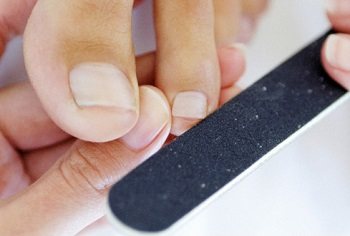
An ingrown toenail should be carefully filed regularly.
At this stage, you can trim the ingrown toenail yourself at home, after thoroughly steaming and softening it, and then carefully prying it up and shortening it. In the future, it is worthwhile to regularly file the diseased nail plate for some time, but for prevention, avoid strong shortening.
If the second or third stages are observed (severe inflammation, formation of pus and other signs), only an experienced surgeon can solve the problem of an ingrown nail.
How to care for your nail after removal
Regardless of the removal method, it is imperative to take care of the remaining wound. This is necessary to prevent inflammatory processes and relapse of infection. Immediately after removal, the surface is disinfected again, healing and antifungal ointments are applied under a gauze bandage. Then treatment is prescribed for both external use and oral administration.
- do the dressing every day until the wound heals;
- keep the dressing sterile and dry. If it gets wet or dirty, replace it immediately;
- in the first days, strict bed rest is prescribed;
- do not put weight on the affected leg while walking;
- During rehabilitation, try not to wear shoes, wear clean socks made of well-ventilated, natural fabric.
If swelling or suppuration appears on the bed, you should urgently consult your doctor. A healthy nail does not grow as quickly as we would like. After two to three weeks, the wound will heal, and you can loosen the strict supervision a little and get prosthetics. On average, a nail grows 3 mm per month. Due to the physiological characteristics of the body, this process occurs more slowly on the legs than on the arms. Thus, the plate will grow back completely no earlier than in six months.
Causes of nail peeling
The nail may peel off for the following reasons:
- the appearance of fungal infections;
- falling a heavy object onto your finger;
- injury during manicure;
- sloppy jump;
- injury;
- compression (when wearing tight shoes).
Whether a nail comes off after an injury depends on its severity. If the wrong tools were used during manicure, then the likelihood that the plate will fall off is low. However, if a nail falls off after a blow, then this is a completely natural pattern. For example, if a heavy object falls on your foot, your big toenail will likely peel off after a few days. The nail falls off in most cases even after strong squeezing.


